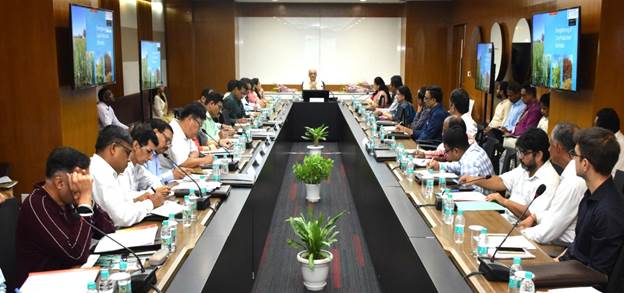The Ministry of Agriculture and Farmers’ Welfare, GoI, under the chairmanship of Shri Devesh Chaturvedi, Secretary, Ministry of Agriculture and Farmers Welfare, convened a national conference today in New Delhi. The event brought together senior officials from all states to discuss and deliberate on the latest initiatives aimed at improving agriculture statistics across the country. These initiatives aim to enhance the accuracy, reliability, and transparency of agricultural statistics, which are crucial for policy formulation, trade decisions and agricultural planning.

The primary focus of the conference was on the enhancement of agricultural production estimates and the integration of technology to strengthen data accuracy. The Digital Crop Survey announced in the present year Budget Speech paves the way for accurate Crop Area Estimation. It will provide plot-level data with geotagged areas of crops and acts as a single source of truth. Digital General Crop Estimation Survey (DGCES) has been initiated to calculate yield based on scientifically designed Crop Cutting Experiments for all major crops across the country. These initiatives are expected to provide near real-time and reliable data directly from the field, which enabling more precise estimations of crop production.
The conference underscored the need for integrating cutting-edge technologies like remote sensing, geospatial analysis and artificial intelligence to enhance the accuracy and reliability of crop production data. Various initiatives taken by the Department of Agriculture &Farmers’ Welfare regarding infusion of technology in generating Crop Production Statistics through revamped FASAL (Forecasting Agricultural output using Space, Agro-meteorology, and Land-based observations) was discussed in detail. This updated version leverages remote sensing technology to generate accurate crop maps & area estimation for 10 major crops. Regarding Yield forecasts, collaboration has been made with various specialized Agencies such as Space Application Center, Indian Agricultural Research Institute, Indian Statistical Institute, Indian Agricultural Statistics Research Institute & Institute of Economic Growth. These Institutions shall work on various models to generate yield estimates of selected crops at PAN India level. Similar Models are also being used under Yes-Tech initiatives of Crop Insurance by various States.
Another critical aspect of the conference was the triangulation and validation of agricultural data using the UPAg Portal. This platform will allow for cross-verification of data from multiple sources, ensuring the robustness of agricultural statistics. It has an advanced data management system that integrates various sources to generate precise crop estimates. It supports evidence based decision-making and serves as a central hub for agricultural data accessible to policymakers and stakeholders.
The conference also pointed out the association of Department of Agriculture &Farmers’ Welfare with MoSPI to increase the supervision of crop cutting experiments with a phased plan by the National Sample Survey Office so as to ensure quality of CCEs and state level yield estimates by independent agency.

The conference also featured a detailed presentation that elaborated on the benefits of these new initiatives. The presentation highlighted how the adoption of digital surveys and advanced technologies will lead to more efficient data collection, reduce discrepancies, and ultimately contribute to better policy-making in the agricultural sector.
Shri Devesh Chaturvedi further emphasized the need for continuous collaboration between the central and state governments to achieve the shared goal of enhancing the quality of agricultural statistics. He encouraged the states to adopt these new initiatives promptly and ensure their effective implementation.
The conference concluded with a consensus on the importance of these reforms and a commitment from all states to work together to strengthen the agricultural statistical framework, which is crucial for the overall development of the agriculture sector in India.

Comments are closed.